Cyanide Hydratase Modification Using Computational Design and Docking Analysis for Improved Binding Affinity in Cyanide Detoxification
Abstract
1. Introduction
2. Results
2.1. Multiple Sequence Alignment and Sequence Analysis
2.2. Homology Modeling and Docking Analysis
2.3. Designing a Mutant of Cyanide Hydratase, Modeling, and Comparing with the Native Enzyme
2.4. Molecular Dynamics Simulation
3. Discussion
4. Materials and Methods
4.1. Cyanide Hydratase (cht) Identification, Multiple Sequence Alignment, and Sequence Analysis
4.2. Homology Modeling and Docking Analysis
4.3. Constructing a Mutant of Cyanide Hydratase, Modeling, and Comparing with Wild-Type Enzyme
4.4. Molecular Dynamics Simulation
5. Conclusions
Author Contributions
Funding
Data Availability Statement
Acknowledgments
Conflicts of Interest
Sample Availability
References
- Luque-Almagro, V.M.; Blasco, F.; Martínez-Luque, M.; Moreno-Vivián, C.; Castillo, F.; Roldán, M.D. Bacterial Cyanide Degradation is under Review: Pseudomonas Pseudoalcaligenes CECT5344, a Case of an Alkaliphilic Cyanotroph. Biochem. Soc. Trans. 2011, 39, 269–274. [Google Scholar] [CrossRef] [PubMed]
- Pinedo-Rivilla, C.; Aleu, J.; Collado, I.G. Pollutants Biodegradation by Fungi. Curr. Org. Chem. 2009, 13, 1194–1214. [Google Scholar] [CrossRef]
- Luque-Almagro, V.M.; Merchán, F.; Blasco, R.; Igeño, M.I.; Martínez-Luque, M.; Moreno-Vivián, C.; Castillo, F.; Roldán, M.D. Cyanide degradation by Pseudomonas pseudoalcaligenes CECT5344 involves a malate: Quinone oxidoreductase and an associated cyanide-insensitive electron transfer chain. Microbiology 2011, 157, 739–746. [Google Scholar] [CrossRef]
- Potivichayanon, S.; Kitleartpornpairoat, R. Biodegradation of cyanide by a novel cyanide-degrading bacterium. World Acad. Sci. Eng. Technol. 2010, 42, 362–1365. [Google Scholar]
- Maniyam, M.N.; Sjahrir, F.; Ibrahim, A.L.; Cass, A.E.G. Biodegradation of cyanide by Rhodococcus UKMP-5M. Biologia 2013, 68, 177–185. [Google Scholar] [CrossRef]
- Zhou, X.; Xu, S.; Liu, L.; Chen, J. Degradation of cyanide by Trichoderma mutants constructed by restriction enzyme mediated integration (REMI). Bioresour. Technol. 2007, 98, 2958–2962. [Google Scholar] [CrossRef]
- Chen, C.; Kao, C.; Chen, S. Application of Klebsiella oxytoca immobilized cells on the treatment of cyanide wastewater. Chemosphere 2008, 71, 133–139. [Google Scholar] [CrossRef]
- White, D.M.; Pilon, T.A.; Woolard, C. Biological treatment of cyanide containing wastewater. Water Res. 2000, 34, 2105–2109. [Google Scholar] [CrossRef]
- Zhou, X.; Liu, L.; Chen, Y.; Xu, S.; Chen, J. Efficient biodegradation of cyanide and ferrocyanide by Na-alginate beads immobilized with fungal cells of Trichoderma koningii. Can. J. Microbiol. 2007, 53, 1033–1037. [Google Scholar] [CrossRef] [PubMed]
- Luque-Almagro, V.M.; Moreno-Vivián, C.; Roldán, M.D. Biodegradation of cyanide wastes from mining and jewellery industries. Curr. Opin. Biotechnol. 2016, 38, 9–13. [Google Scholar] [CrossRef]
- Handelsman, J. Metagenomics: Application of Genomics to Uncultured Microorganisms. Microbiol. Mol. Biol. Rev. 2004, 68, 669–685. [Google Scholar] [CrossRef]
- Kumar, V.; Kumar, V.; Bhalla, T.C. Alkaline active cyanide dihydratase of Flavobacterium indicum MTCC 6936: Growth optimization, purification, characterization and in silico analysis. Int. J. Biol. Macromol. 2018, 116, 591–598. [Google Scholar] [CrossRef]
- Gong, J.-S.; Lu, Z.-M.; Li, H.; Shi, J.-S.; Zhou, Z.-M.; Xu, Z.-H. Nitrilases in nitrile biocatalysis: Recent progress and forthcoming research. Microb. Cell Factories 2012, 11, 142. [Google Scholar] [CrossRef] [PubMed]
- Chien, C.H.; Gao, Q.Z.; Cooper, A.J.; Lyu, J.H.; Sheu, S.Y. Structural Insights into the Catalytic Active Site and Activity of Human Nit2/ω-Amidase kinetic assay and molecular dynamics simulation. J. Biol. Chem. 2012, 287, 25715–25726. [Google Scholar] [CrossRef] [PubMed]
- Jiang, S.; Zhang, L.; Yao, Z.; Gao, B.; Wang, H.; Mao, X.; Wei, D. Switching a nitrilase from Syechocystis sp. PCC6803 to a nitrile hydratase by rationally regulating reaction pathways. Catal. Sci. Technol. 2017, 7, 1122–1128. [Google Scholar] [CrossRef]
- Raczynska, J.E.; Vorgias, C.E.; Antranikian, G.; Rypniewski, W. Crystallographic analysis of a thermoactive nitrilase. J. Struct. Biol. 2011, 173, 294–302. [Google Scholar] [CrossRef]
- Gasteiger, E.; Hoogland, C.; Gattiker, A.; Duvaud, S.; Wilkins, M.R.; Bairoch, R.D.A.A. Protein identification and analysis tools on the ExPASy server. In The Proteomics Protocols Handbook; Springer: Berlin/Heidelberg, Germany, 2005; pp. 571–607. [Google Scholar]
- Buchan, D.W.; Jones, D.T. The PSIPRED protein analysis workbench: 20 years on. Nucleic Acids Res. 2019, 47, W402–W407. [Google Scholar] [CrossRef]
- El-Gebali, S.; Mistry, J.; Bateman, A.; Eddy, S.R.; Luciani, A.; Potter, S.C.; Qureshi, M.; Richardson, L.J.; A Salazar, G.; Smart, A.; et al. The Pfam protein families database in 2019. Nucleic Acids Res. 2018, 47, D427–D432. [Google Scholar] [CrossRef]
- Finn, R.D.; Attwood, T.K.; Babbitt, P.C.; Bateman, A.; Bork, P.; Bridge, A.J.; Chang, H.-Y.; Dosztányi, Z.; El-Gebali, S.; Fraser, M.; et al. InterPro in 2017—beyond protein family and domain annotations. Nucleic Acids Res. 2017, 45, D190–D199. [Google Scholar] [CrossRef] [PubMed]
- Lu, S.; Wang, J.; Chitsaz, F.; Derbyshire, M.K.; Geer, R.C.; Gonzales, N.R.; Gwadz, M.; I Hurwitz, D.; Marchler, G.H.; Song, J.S.; et al. CDD/SPARCLE: The conserved domain database in 2020. Nucleic Acids Res. 2020, 48, D265–D268. [Google Scholar] [CrossRef] [PubMed]
- McWilliam, H.; Li, W.; Uludag, M.; Squizzato, S.; Park, Y.M.; Buso, N.; Cowley, A.P.; Lopez, R. Analysis Tool Web Services from the EMBL-EBI. Nucleic Acids Res. 2013, 41, W597–W600. [Google Scholar] [CrossRef] [PubMed]
- Zhang, L.; Yin, B.; Wang, C.; Jiang, S.; Wang, H.; Yuan, Y.A.; Wei, D. Structural insights into enzymatic activity and substrate specificity determination by a single amino acid in nitrilase from Syechocystis sp. PCC6803. J. Struct. Biol. 2014, 188, 93–101. [Google Scholar] [CrossRef]
- Schwede, T.; Kopp, J.; Guex, N.; Peitsch, M.C. SWISS-MODEL: An automated protein homology-modeling server. Nucleic Acids Res. 2003, 31, 3381–3385. [Google Scholar] [CrossRef] [PubMed]
- Pettersen, E.F.; Goddard, T.D.; Huang, C.C.; Couch, G.S.; Greenblatt, D.M.; Meng, E.C.; Ferrin, T.E. UCSF Chimera—A visualization system for exploratory research and analysis. J. Comput. Chem. 2004, 25, 1605–1612. [Google Scholar] [CrossRef] [PubMed]
- Goecks, J.; Nekrutenko, A.; Taylor, J.; The Galaxy Team. Galaxy: A comprehensive approach for supporting accessible, reproducible, and transparent computational research in the life sciences. Genome Biol. 2010, 11, R86. [Google Scholar] [CrossRef] [PubMed]
- Laskowski, R.A.; MacArthur, M.W.; Moss, D.S.; Thornton, J.M. PROCHECK: A program to check the stereochemical quality of protein structures. J. Appl. Crystallogr. 1993, 26, 283–291. [Google Scholar] [CrossRef]
- Eisenberg, D.; Lüthy, R.; Bowie, J.U. [20] VERIFY3D: Assessment of protein models with three-dimensional profiles. In Methods in Enzymology; Elsevier BV: Amsterdam, The Netherlands, 1997; Volume 277, pp. 396–404. [Google Scholar]
- Pontius, J.; Richelle, J.; Wodak, S.J. Deviations from Standard Atomic Volumes as a Quality Measure for Protein Crystal Structures. J. Mol. Biol. 1996, 264, 121–136. [Google Scholar] [CrossRef]
- Colovos, C.; Yeates, T.O. Verification of protein structures: Patterns of nonbonded atomic interactions. Protein Sci. 1993, 2, 1511–1519. [Google Scholar] [CrossRef]
- Wiederstein, M.; Sippl, M.J. ProSA-web: Interactive web service for the recognition of errors in three-dimensional structures of proteins. Nucleic Acids Res. 2007, 35, W407–W410. [Google Scholar] [CrossRef] [PubMed]
- Thomsen, R.; Christensen, M.H. MolDock: A New Technique for High-Accuracy Molecular Docking. J. Med. Chem. 2006, 49, 3315–3321. [Google Scholar] [CrossRef] [PubMed]
- Irwin, J.J.; Shoichet, B.K. ZINC − A Free Database of Commercially Available Compounds for Virtual Screening. J. Chem. Inf. Model. 2005, 45, 177–182. [Google Scholar] [CrossRef]
- Amirzakaria, J.Z.; Malboobi, M.A.; Marashi, S.-A.; Lohrasebi, T. In silico prediction of enzymatic reactions catalyzed by acid phosphatases. J. Biomol. Struct. Dyn. 2020, 1–12. [Google Scholar] [CrossRef] [PubMed]
- Schrodinger, L. The PyMOL Molecular Graphics System; Version 2010; Schrödinger, Inc.: New York, NY, USA, 2010. [Google Scholar]
- Gordon, J.C.; Myers, J.B.; Folta, T.; Shoja, V.; Heath, L.S.; Onufriev, A. H++: A server for estimating p K as and adding missing hydrogens to macromolecules. Nucleic Acids Res. 2005, 33, W368–W371. [Google Scholar] [CrossRef]
- Johansson, M.U.; Zoete, V.; Michielin, O.; Guex, N. Defining and searching for structural motifs using DeepView/Swiss-PdbViewer. BMC Bioinform. 2012, 13, 173. [Google Scholar] [CrossRef]
- Hess, B.; Kutzner, C.; Van Der Spoel, D.; Lindahl, E. GROMACS 4: Algorithms for Highly Efficient, Load-Balanced, and Scalable Molecular Simulation. J. Chem. Theory Comput. 2008, 4, 435–447. [Google Scholar] [CrossRef]
- Schmid, N.; Eichenberger, A.P.; Choutko, A.; Riniker, S.; Winger, M.; Mark, A.E.; Van Gunsteren, W.F. Definition and testing of the GROMOS force-field versions 54A7 and 54B7. Eur. Biophys. J. 2011, 40, 843–856. [Google Scholar] [CrossRef] [PubMed]
- Darden, T.; Perera, L.; Li, L.; Pedersen, L. New tricks for modelers from the crystallography toolkit: The particle mesh Ewald algorithm and its use in nucleic acid simulations. Structure 1999, 7, R55–R60. [Google Scholar] [CrossRef]
- Abraham, M.J.; Van Der Spoel, D.; Lindahl, E.; Hess, B. The GROMACS development team. GROMACS User Manual Version. 2014, 5, 1–298. [Google Scholar]
- Ikai, A. Thermostability and Aliphatic Index of Globular Proteins. J. Biochem. 1980, 88, 1895–1898. [Google Scholar]
- Guruprasad, K.; Reddy, B.; Pandit, M.W. Correlation between stability of a protein and its dipeptide composition: A novel approach for predicting in vivo stability of a protein from its primary sequence. Protein Eng. Des. Sel. 1990, 4, 155–161. [Google Scholar] [CrossRef]
- Sehgal, S.A.; Mirza, A.H.; Tahir, R.A.; Mir, A. Quick Guideline for Computational Drug Design; Bentham Science Publishers: Sharjah, United Arab Emirates, 2018. [Google Scholar]
- Wu, S.; Fogiel, A.J.; Petrillo, K.L.; Jackson, R.E.; Parker, K.N.; DiCosimo, R.; Ben-Bassat, A.; O’Keefe, D.P.; Payne, M.S. Protein engineering of nitrilase for chemoenzymatic production of glycolic acid. Biotechnol. Bioeng. 2007, 99, 717–720. [Google Scholar] [CrossRef]
- Huku, R.N.; Brady, D.; Benedik, M.J.; Sewell, B.T. Microbial nitrilases: Versatile, spiral forming, industrial enzymes. J. Appl. Microbiol. 2009, 106, 703–727. [Google Scholar]
- Nolan, L.M.; Harnedy, P.A.; Turner, P.; Hearne, A.B.; O’Reilly, C. The cyanide hydratase enzyme of Fusarium lateritium also has nitrilase activity. FEMS Microbiol. Lett. 2003, 221, 161–165. [Google Scholar] [CrossRef]
- Howden, A.J.M.; Preston, G.M. Nitrilase enzymes and their role in plant-microbe interactions. Microb. Biotechnol. 2009, 2, 441–451. [Google Scholar] [CrossRef]
- Zhang, J.-F.; Liu, Z.-Q.; Zheng, Y.-G. Improvement of nitrilase production from a newly isolated Alcaligenes faecalis mutant for biotransformation of iminodiacetonitrile to iminodiacetic acid. J. Taiwan Inst. Chem. Eng. 2013, 44, 169–176. [Google Scholar] [CrossRef]
- Yanase, H.; Sakamoto, A.; Okamoto, K.; Kita, K.; Sato, Y. Degradation of the metal-cyano complex tetracyanonickelate (II) by Fusarium oxysporum N-10. Appl. Microbiol. Biotechnol. 2000, 53, 328–334. [Google Scholar] [CrossRef]
- Kaplan, O.; Vejvoda, V.; Charvátová-Pišvejcová, A.; Martínková, L. Hyperinduction of nitrilases in filamentous fungi. J. Ind. Microbiol. Biotechnol. 2006, 33, 891–896. [Google Scholar] [CrossRef] [PubMed]
- Sosedov, O.; Stolz, A. Random mutagenesis of the arylacetonitrilase from Pseudomonas fluorescens EBC191 and identification of variants, which form increased amounts of mandeloamide from mandelonitrile. Appl. Microbiol. Biotechnol. 2014, 98, 1595–1607. [Google Scholar] [CrossRef] [PubMed]
- Sosedov, O.; Baum, S.; Bürger, S.; Matzer, K.; Kiziak, C.; Stolz, A. Construction and application of variants of the Pseudomonas fluorescens EBC191 arylacetonitrilase for increased production of acids or amides. Appl. Environ. Microbiol. 2010, 76, 3668–3674. [Google Scholar] [CrossRef] [PubMed]

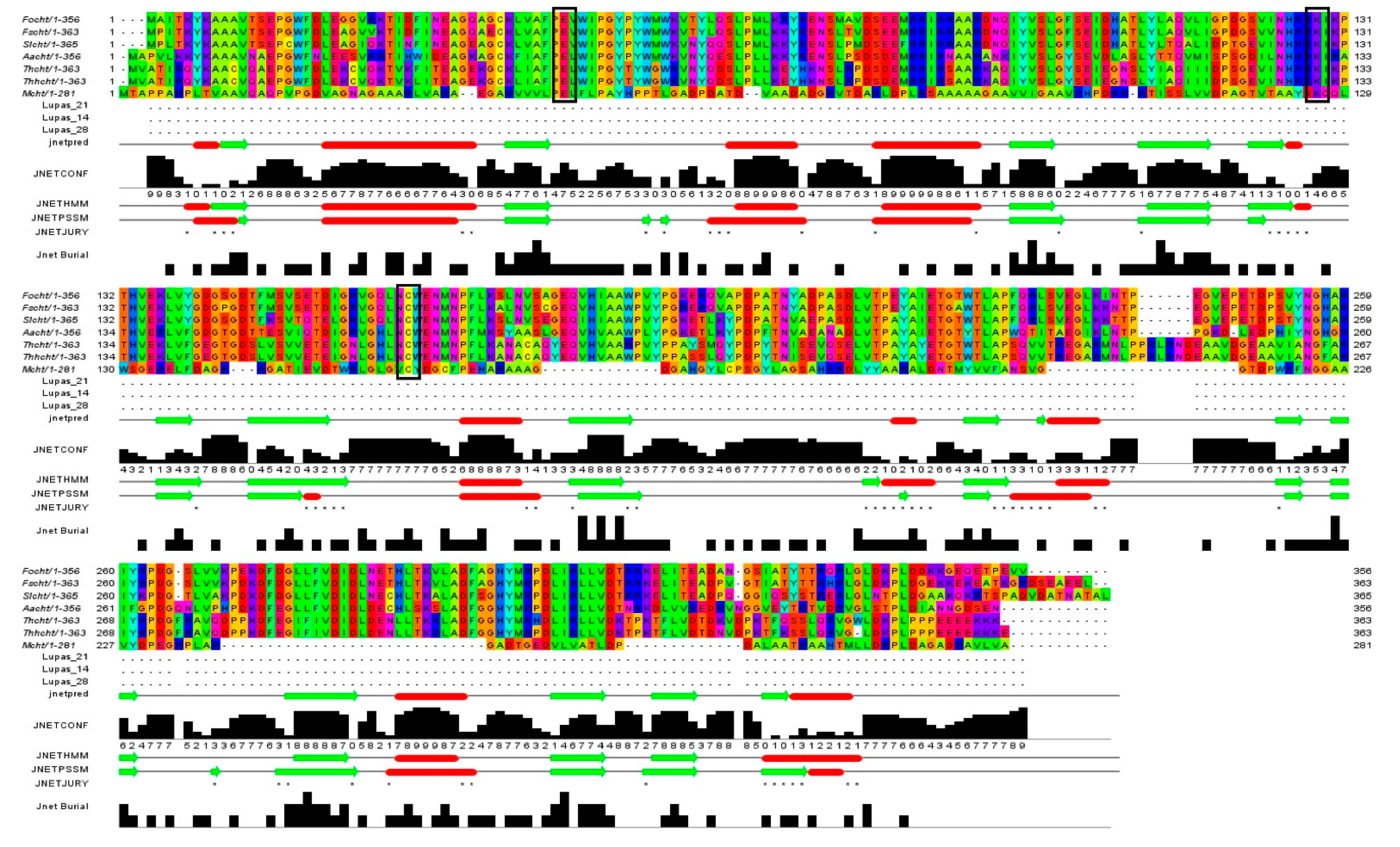

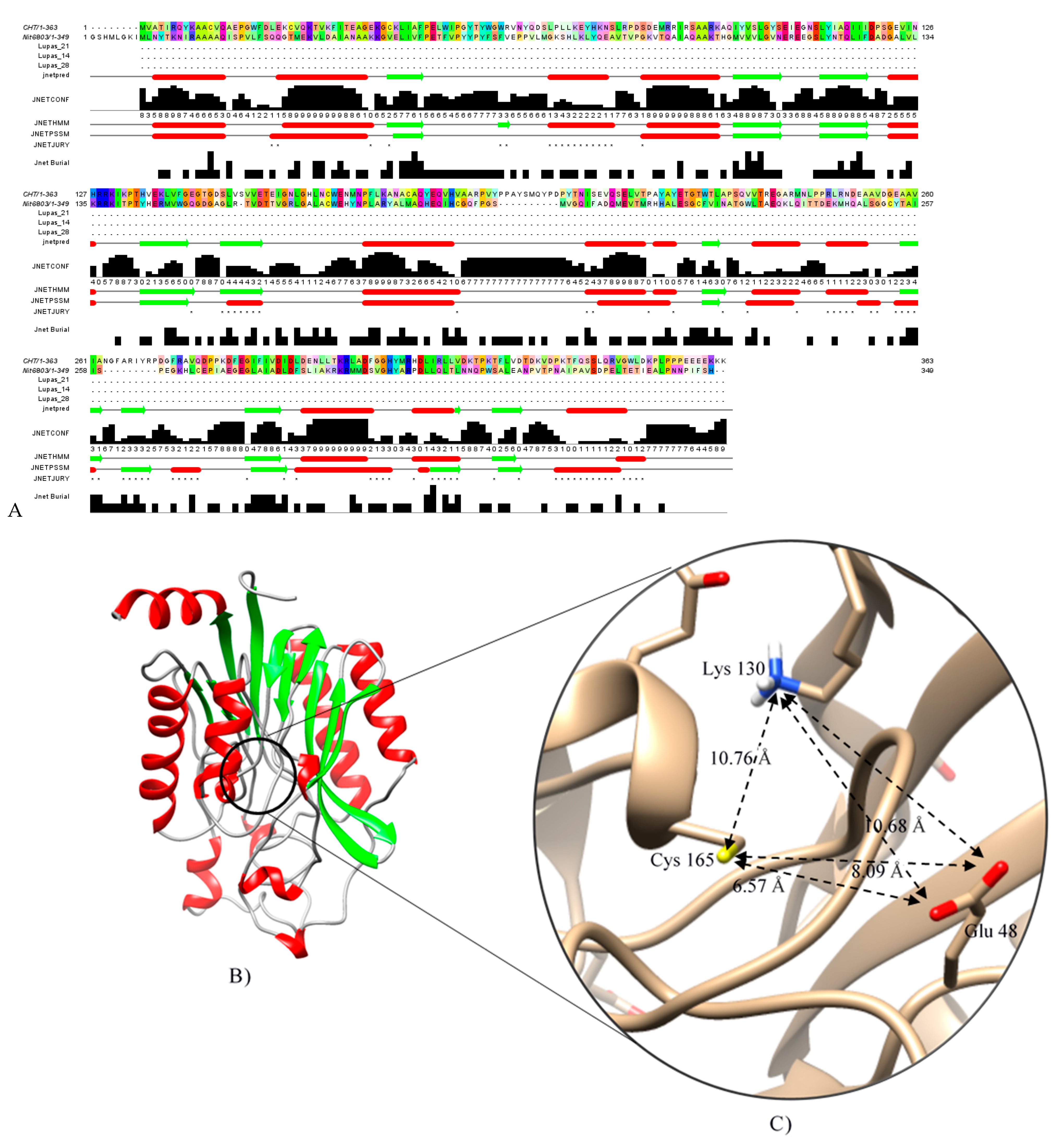
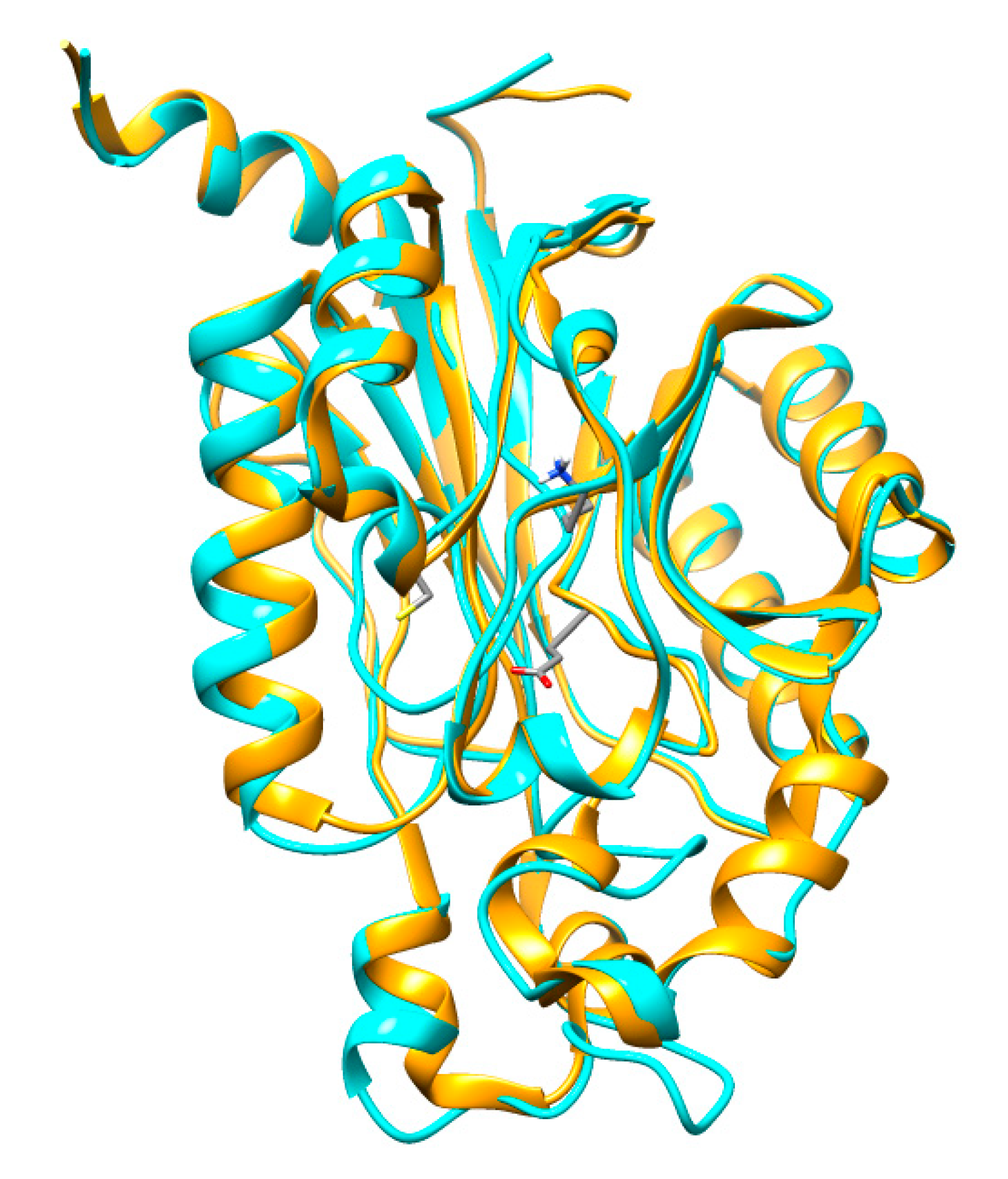
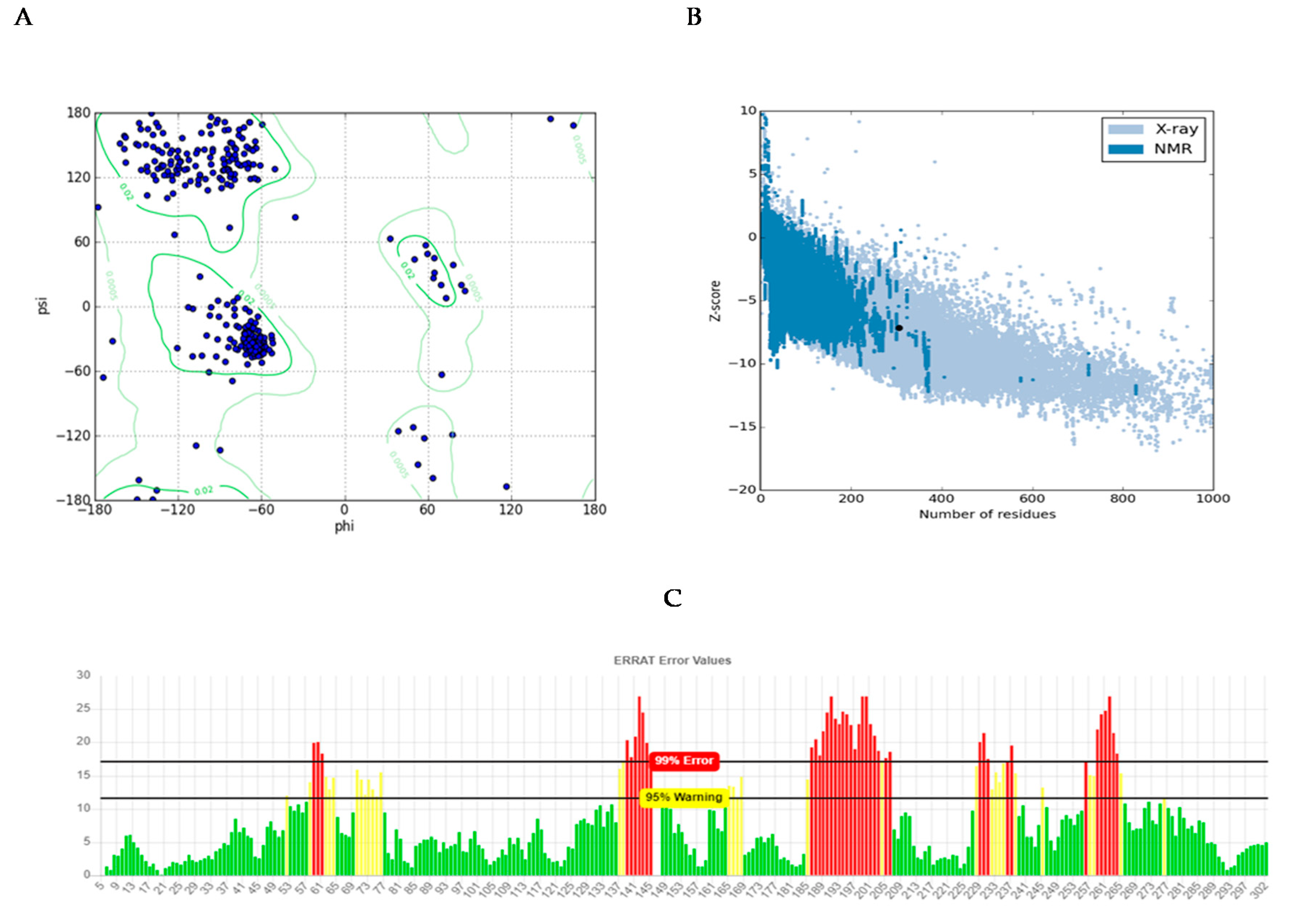
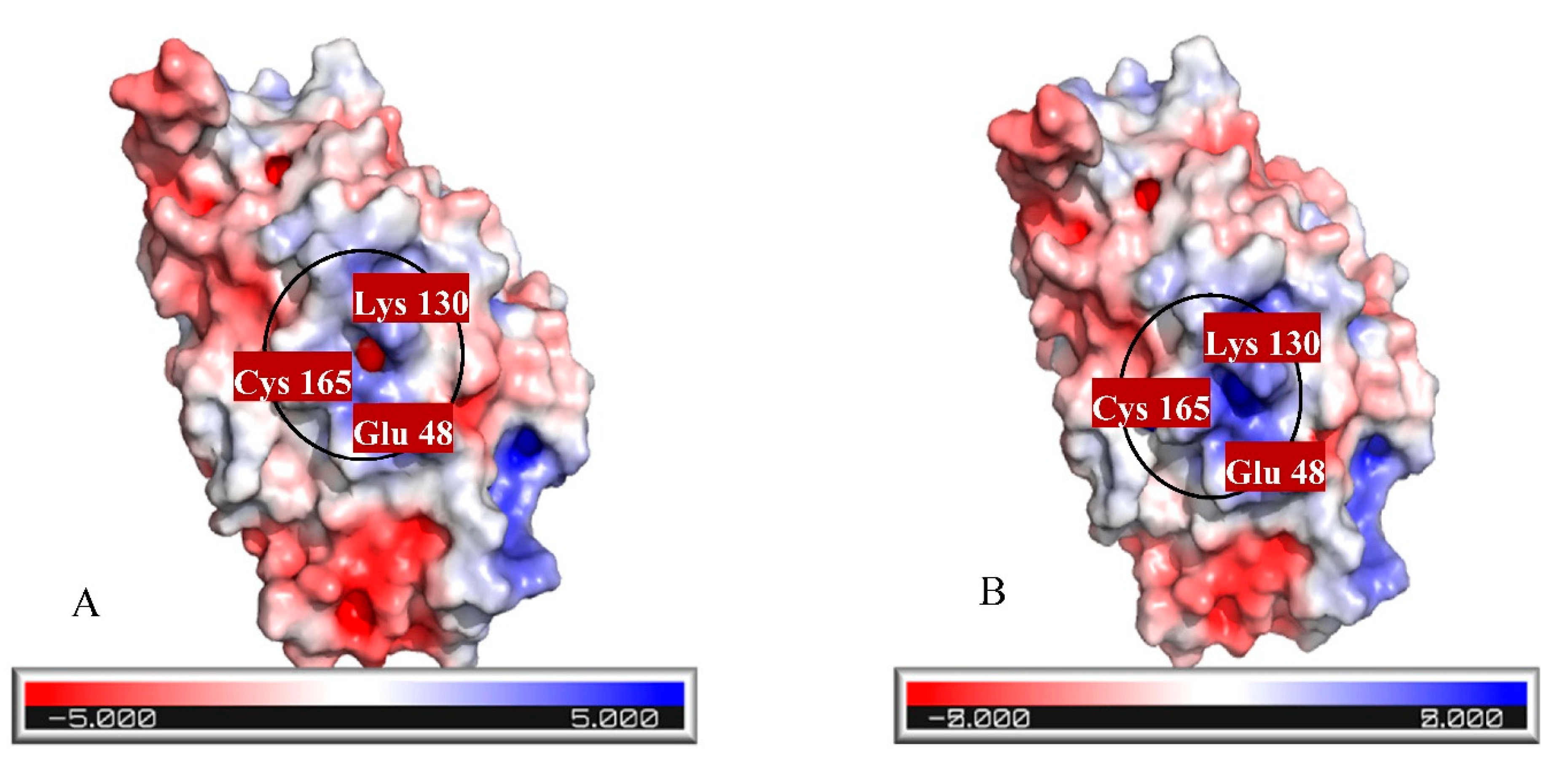

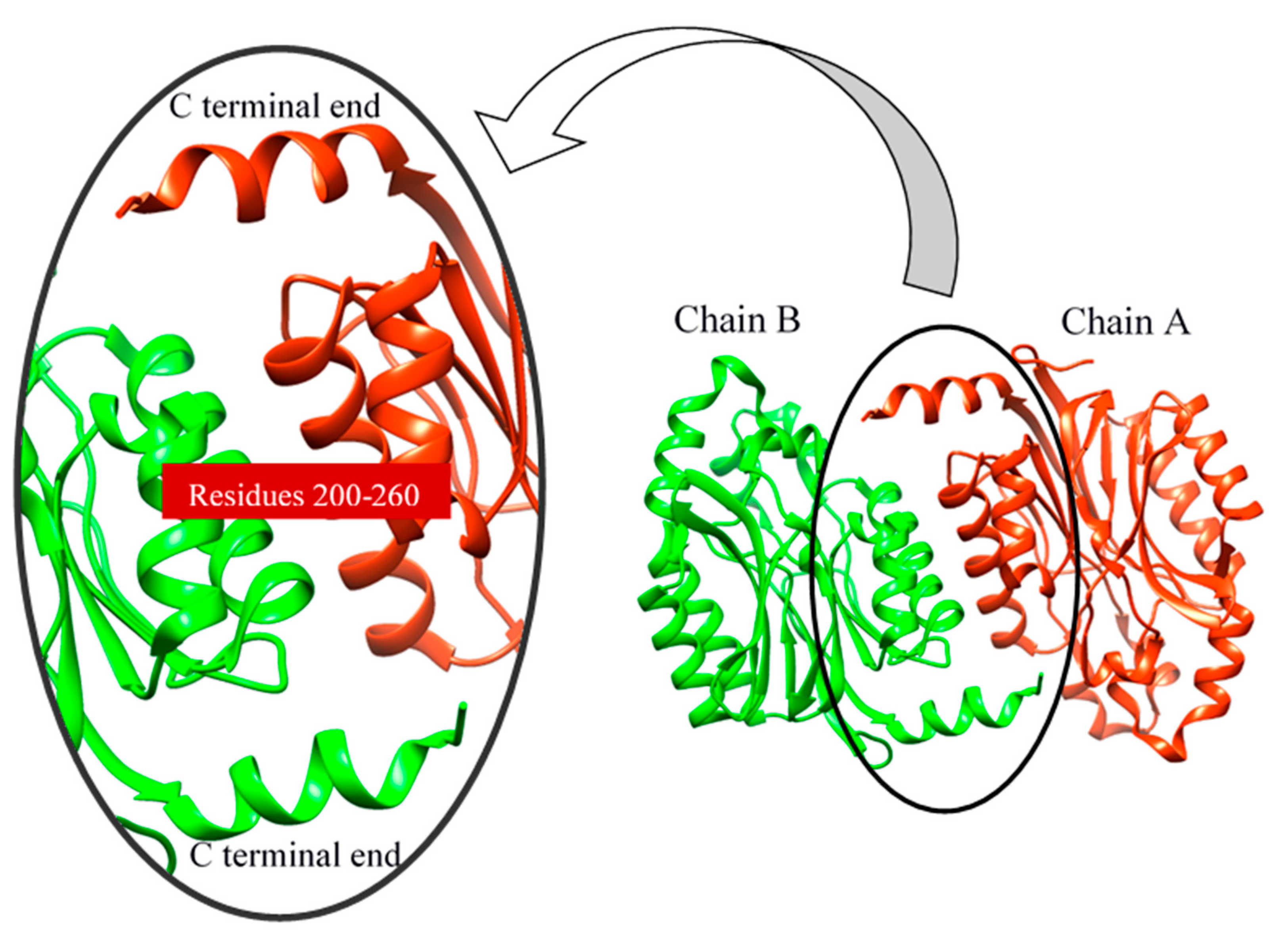
| Fungi Containing Cyanide Hydratase | MolDock Score |
|---|---|
| Aspergillus awamori | −23.6224 |
| Fusarium oxysporum | −25.2489 |
| Fusarium solani | −22.9649 |
| Micromonospora sp. L5 | −21.0853 |
| Stemphylium lycopersici | −18.8413 |
| Trichoderma harzianum | −24.44 |
| Indigenous Trichoderma harzianum | −18.1752 |
| Type of Residues | Number of Residues | Type of Residues | Number of Residues |
|---|---|---|---|
| Tyr | 54 | Val | 191 |
| Tyr | 56 | Tyr | 192 |
| Lys | 132 | Pro | 193 |
| Thr | 134 | Pro | 194 |
| Asn | 164 | Ala | 195 |
| Cys | 165 | Tyr | 196 |
| Trp | 166 | Gln | 199 |
| Glu | 167 | Tyr | 200 |
| Asn | 168 | Pro | 201 |
| Pro | 190 | Tyr | 204 |
| Fungi Containing Cyanide Hydratase | A1 | B2 | C3 |
|---|---|---|---|
| Aspergillus awamori | 7.70 Å | 1.39 Å | 6.58 Å |
| Fusarium oxysporum | 6.13 Å | 4.62 Å | 3.98 Å |
| Fusarium solani | 8.34 Å | 3.76 Å | 9.57 Å |
| Micromonospora sp. L5 | 9.23 Å | 4.39 Å | 12.76 Å |
| Stemphylium lycopersici | 3.77 Å | 3.60 Å | 3.09 Å |
| Trichoderma harzianum | 6.12 Å | 4.05 Å | 5.36 Å |
| Indigenous Trichoderma harzianum | 7.34 Å | 4.61 Å | 6.57 Å |
| Type of Protein | Wild Type Protein | Mutant Protein |
|---|---|---|
| Moldock Score | −18.1752 | −23.8575 |
| Cyanide Hydratase of Indigenous Trichoderma harzianum | A4 | B5 | C6 |
|---|---|---|---|
| Wild-Type | 7.34 Å | 4.61 Å | 6.57 Å |
| Mutant | 7.22 Å | 5.00 Å of Cys165 and 4.52 Å of Cys191 | 6.57 Å |
| Mutant Protein | Native Protein |
|---|---|
| Glu48: <0.0 | Glu48: 3.441 |
| Lys130: <0.0 | Lys130: 0.483 |
| Cys165: >12.0 | Cys165: >12.0 |
Publisher’s Note: MDPI stays neutral with regard to jurisdictional claims in published maps and institutional affiliations. |
© 2021 by the authors. Licensee MDPI, Basel, Switzerland. This article is an open access article distributed under the terms and conditions of the Creative Commons Attribution (CC BY) license (http://creativecommons.org/licenses/by/4.0/).
Share and Cite
Malmir, N.; Fard, N.A.; Mgwatyu, Y.; Mekuto, L. Cyanide Hydratase Modification Using Computational Design and Docking Analysis for Improved Binding Affinity in Cyanide Detoxification. Molecules 2021, 26, 1799. https://doi.org/10.3390/molecules26061799
Malmir N, Fard NA, Mgwatyu Y, Mekuto L. Cyanide Hydratase Modification Using Computational Design and Docking Analysis for Improved Binding Affinity in Cyanide Detoxification. Molecules. 2021; 26(6):1799. https://doi.org/10.3390/molecules26061799
Chicago/Turabian StyleMalmir, Narges, Najaf Allahyari Fard, Yamkela Mgwatyu, and Lukhanyo Mekuto. 2021. "Cyanide Hydratase Modification Using Computational Design and Docking Analysis for Improved Binding Affinity in Cyanide Detoxification" Molecules 26, no. 6: 1799. https://doi.org/10.3390/molecules26061799
APA StyleMalmir, N., Fard, N. A., Mgwatyu, Y., & Mekuto, L. (2021). Cyanide Hydratase Modification Using Computational Design and Docking Analysis for Improved Binding Affinity in Cyanide Detoxification. Molecules, 26(6), 1799. https://doi.org/10.3390/molecules26061799







